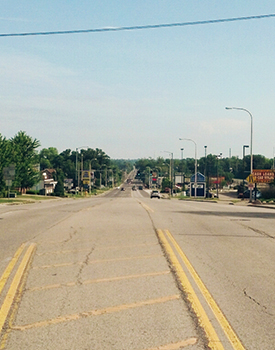All Places Are Not Created Equal

Understanding the difference between “place” and “Place”
Assembling the elements that make a place great is a tough challenge no matter the street, neighborhood or city. In areas that exhibit blight, deterioration and lack of reinvestment, what had previously been a focal physical space in decades past may no longer demonstrate the qualities needed to connect the local community.
In 2015, Greater Peoria LISC will launch its Creative Placemaking initiative, which will focus in its target neighborhoods of the East Bluff and South Side. “Placemaking” has been a relatively hot buzzword around the community development water cooler for the past couple years. To understand the term and the capabilities of its actions, it helps to distinguish the difference between “place” and “Place.”
A Higher-Order Concept
According to the 2011 book, The Economics of Place, we refer to places in the typical geographic context as place with a lower-case “p.” On the other hand, we refer to places with allure that are created to attract people and businesses, improve quality of life and increase economic competitiveness as places with an upper-case “P.”
Place is a higher-order concept that goes beyond locations and their attributes and includes the effects of all of those attributes on advancing specific social, environmental and economic objectives.
At the intersection of “X” and “Y” streets with a building or two and a stoplight, there’s not much to warrant any emotion. Now, add a couple of locally-owned businesses, a coffee shop, outdoor seating, public art, flowers, trees, a transit stop… and you’ve created an inviting, welcoming atmosphere that brings people together. This Place creates positive connections.
Making a Great Place
The Project for Public Spaces is a nonprofit organization that has pioneered the concept of “Place” and its role in our everyday lives. For reference, the diagram below was created to help connect the many dots of individual pieces to make a more meaningful public space. Provided as an open-source tool available to community builders everywhere, these key attributes, intangibles and measurements have been observed, studied and tested for decades across the world.
In Peoria, successfully transforming blight and deterioration takes focused, intentional reinvestment. Applying best practices from around the globe is a good start, but engaging the residents who live in the community is vital to its longevity. There are plenty of opportunities to mix creativity and fun with work when it comes to the place you also live and play.
If a community has enough Places, then the community itself becomes a special Place. We invite you to take an active role in re-establishing spaces that make lives better. As a community leader, your contribution—as an individual or through a corporate partnership—can go a long way towards restoring some of Peoria’s oldest neighborhoods and making a huge, visible impact in the process. Contact Greater Peoria LISC today to learn more about the Creative Placemaking initiative. iBi
Brandon Holmes is the executive director of Greater Peoria LISC (Local Initiatives Support Corporation), a registered 501(c)3. Established in New York City in 1979, it opened its doors in Peoria in 2012. For more information, visit lisc.org/peoria or call (309) 676-5472.

